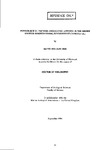PHYSIOLOGICAL FACTORS REGULATING APPETITE IN THE LESSER SPOTTED DOGFISH SHARK, SCYLIORHINUS CANICULA (L.)
| dc.contributor.author | SIMS, DAVID WILLIAM | |
| dc.contributor.other | School of Biological and Marine Sciences | en_US |
| dc.date.accessioned | 2013-10-23T10:21:02Z | |
| dc.date.available | 2013-10-23T10:21:02Z | |
| dc.date.issued | 1994 | |
| dc.identifier | NOT AVAILABLE | en_US |
| dc.identifier.uri | http://hdl.handle.net/10026.1/2312 | |
| dc.description.abstract |
Some aspects of digestive and systemic function were investigated in relation to their role in the peripheral regulation of appetite in juvenile and adult, S. canicula. This study represents the first evaluation of the physiological factors that contribute to the control of shark appetite. Daily food intake trials on both juvenile and adult dogfish showed repeatable, self-regulated feeding rhythms indicating the existence of an endogenous component to food intake control. After dogfish consumed satiation meals of 7% wet body weight (wbw) the appetite return increased at constant rates as deprivation time increased. The relative rate of food processing was 50% faster in juveniles than adults. The pattern of gastric emptying of squid diet was exponential and dependent on the degree of stomach fullness, with meals of different size being emptied at different relative rates. It was also shown that dogfish were capable of shunting undigested food into the intestine soon after consumption of large meals. There was inverse proportionality between rate of gastric evacuation and appetite return rate indicating the importance of the physiological perception of relative stomach emptiness in the establishment of appetite. Gastric emptying rates were not influenced by changes in the digestible energy level of the diet, which suggests this shark exhibits a predominantly bulk dependent feeding pattern. Increases in post-prandial metabolism or specific dynamic action (SDA) did not seemingly alter the rate of appetite return in dogfish, though SDA and appetite return were shown to be closely linked metabolic processes. The SDA process in dogfish may have a saturation level determined by cellular metabolism rather than by the respiratory system. The levels of plasma glucose remained uniform after food consumption. The concentrations of triglycerides and protein in plasma were closely controlled post-prandially, suggesting a possible role for these metabolites as systemic signals of metabolic satiety. The results of this investigation are discussed with regard to the multifactorial control of appetite in sharks and the possible use of physiological studies of appetite in the further understanding of fish feeding strategies. | en_US |
| dc.description.sponsorship | Marine Biological Association of the United Kingdom | en_US |
| dc.language.iso | en | en_US |
| dc.publisher | University of Plymouth | en_US |
| dc.title | PHYSIOLOGICAL FACTORS REGULATING APPETITE IN THE LESSER SPOTTED DOGFISH SHARK, SCYLIORHINUS CANICULA (L.) | en_US |
| dc.type | Thesis | |
| dc.identifier.doi | http://dx.doi.org/10.24382/3636 | |
| dc.identifier.doi | http://dx.doi.org/10.24382/3636 |
Files in this item
This item appears in the following Collection(s)
-
01 Research Theses Main Collection
Research Theses Main


